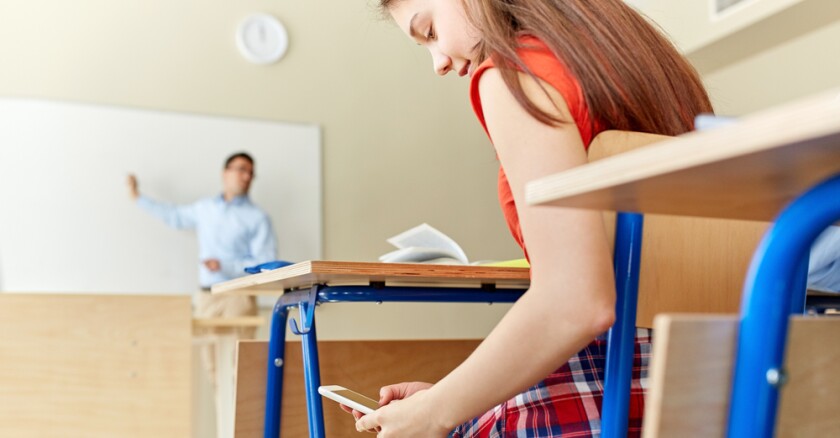Science
New York Schools Embrace Cellphone Restrictions for Better Focus

New York schools are preparing to implement a new law that restricts cellphone use during school hours, a measure designed to enhance student focus and reduce bullying. The legislation, signed by Governor Kathy Hochul, mandates a “bell-to-bell” cellphone policy, requiring students to keep their devices stored from the beginning to the end of the school day. The law takes effect with the upcoming academic year, and various districts are already adopting their own versions of the policy.
Among the early adopters is the Cambridge Central School District, which introduced a similar policy last year. According to Ralph Harrington, the secondary associate principal, the results have been encouraging. He noted that disciplinary referrals for cellphone use have dropped significantly. Harrington explained, “Prior to the policy, cellphones contributed to substantial bullying and harassment, as students recorded each other and shared videos online.” With the new rules in place, he reported that these issues have largely vanished, allowing students to focus more on their studies.
The Cambridge district opted for a nuanced approach rather than an outright ban on cellphones. Students who bring their devices to school must place them in Yondr pouches that lock the phones inside at the start of the day. They regain access to their phones only after school. This method has helped mitigate the distractions posed by smartphones, which Harrington likened to allowing a child to bring a television to class.
Under the new state law, while cellphone use is restricted, students are still permitted to possess their devices. School districts have the flexibility to design their own policies. Some may impose total bans, while others, like Cambridge, may adopt the Yondr pouch method. The state has allocated $13.5 million to support schools in acquiring storage solutions. Importantly, the law also requires schools to provide a way for parents to contact their children during emergencies.
Districts are actively addressing parental concerns about emergency communications. Harrington reassured parents that the pouches can be cut open if necessary. He also emphasized that excessive cellphone use during emergencies can overwhelm communication systems, potentially hindering first responders.
The experience at Cambridge reflects a broader trend across New York. For instance, the Hudson Falls Central School District has developed a cellphone policy after consulting with various stakeholders, including parents and teachers. Their approach prohibits the use of “Internet-enabled devices” during the school day, with certain exemptions for educational purposes or emergencies. The district will also provide designated storage areas for students’ phones.
In a similar vein, the Queensbury School District has enforced its own cellphone procedures, which will now align with the new state law. Superintendent Kyle Gannon noted that the previous policy allowed high school students to use their phones only during lunch. The new regulations will extend the restrictions throughout the school day, promoting engagement among students. Principal Andrew Snide observed an immediate improvement in classroom dynamics, as students spent more time interacting with each other rather than focusing on their devices.
Meanwhile, the Lake George School District has tailored its policy for both high school and elementary students. High school students will be required to store their devices in lockers, with strict rules about keeping them silent or powered off throughout the day. Superintendent John Luthringer highlighted that this marked a significant shift, aligning with the statewide mandate and aiming to reduce distractions while enhancing peer engagement.
As the new school year approaches, districts across New York are finalizing and communicating their cellphone policies. Each district is required to make its policy public by August 1, providing parents and students with the necessary information for compliance. With the implementation of these measures, schools hope to foster a more focused and productive learning environment for all students.
-

 Health3 months ago
Health3 months agoNeurologist Warns Excessive Use of Supplements Can Harm Brain
-

 Health3 months ago
Health3 months agoFiona Phillips’ Husband Shares Heartfelt Update on Her Alzheimer’s Journey
-

 Science2 months ago
Science2 months agoBrian Cox Addresses Claims of Alien Probe in 3I/ATLAS Discovery
-

 Science2 months ago
Science2 months agoNASA Investigates Unusual Comet 3I/ATLAS; New Findings Emerge
-

 Science1 month ago
Science1 month agoScientists Examine 3I/ATLAS: Alien Artifact or Cosmic Oddity?
-

 Entertainment5 months ago
Entertainment5 months agoKerry Katona Discusses Future Baby Plans and Brian McFadden’s Wedding
-

 Science1 month ago
Science1 month agoNASA Investigates Speedy Object 3I/ATLAS, Sparking Speculation
-

 Entertainment4 months ago
Entertainment4 months agoEmmerdale Faces Tension as Dylan and April’s Lives Hang in the Balance
-

 World3 months ago
World3 months agoCole Palmer’s Cryptic Message to Kobbie Mainoo Following Loan Talks
-

 Science1 month ago
Science1 month agoNASA Scientists Explore Origins of 3I/ATLAS, a Fast-Moving Visitor
-

 Entertainment2 months ago
Entertainment2 months agoLewis Cope Addresses Accusations of Dance Training Advantage
-

 Entertainment3 months ago
Entertainment3 months agoMajor Cast Changes at Coronation Street: Exits and Returns in 2025









